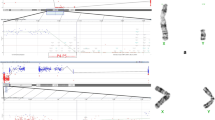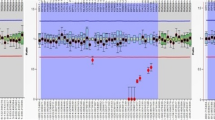Abstract
Purpose
Worldwide publications follow the gold standard method—the polymerase chain reaction (PCR)—for detecting Y-chromosome microdeletions; however, markers are frequently variable between the studies. Can we detect the deletions by another molecular method with more genomic coverage? The Y chromosome harbors several different genes responsible for testicular development and spermatogenesis, and its repetitive conformation predisposes it to complex rearrangements that have clinical impact. Our aim was to evaluate a molecular diagnostic method, the Multiplex Ligand Probe-dependent Amplification (MLPA), which is also a valuable ancillary method for the identification of deletions, duplications, and rearrangements in a single and faster reaction, leading to a better comprehension of patients’ phenotypes, and should be considered a useful tool for detection of Y chromosome deletions.
Methods
This is a study of diagnostic accuracy (transversal prospective study) conducted to investigate Y-chromosome deletions in 84 individuals through PCR and MLPA methods. Forty-three infertile men (azoospermic and oligozoospermic) and 41 controls (40 fertile men and 1 normal karyotyped woman) were analyzed by PCR and MLPA techniques.
Results
We diagnosed seven (7) deletions (16.2%) by PCR and 9 with MLPA (21%). In addition, we found five (5) duplications and a suggestive mosaic.
Conclusion
Our results demonstrate that MLPA technique is valuable in the investigation of microdeletions and microduplications. Besides deletions, duplications can cause instability of chromosome genes, possibly leading to infertility. Both studied techniques provide an advantageous diagnostic strategy, thus enabling a better genetic counseling.




Similar content being viewed by others
References
Krausz C, Hoefsloot L, Simoni M, Tüttelmann F. EAA/EMQN best practice guidelines for molecular diagnosis of Y-chromosomal microdeletions: State-of-the-art 2013. Andrology. 2014;2:5–19.
Esteves SC, Agarwal A. Novel concepts in male infertility. Int Braz J Urol. 2011;37:5–15.
Kamp C, Hirschmann P, Voss H, Huellen K, Vogt PH. Two long homologous retroviral sequence blocks in proximal Yq11 cause AZFa microdeletions as a result of intrachromosomal recombination events. Hum Mol Genet. 2000;9:2563–72.
Krausz C, Casamonti E. Spermatogenic failure and the Y chromosome. Hum. Genet. 2017;136:637–55.
Quintana-Murci L, Krausz C, McElreavey K. The human Y chromosome: function, evolution and disease. Forensic Sci Int. 2001;118:169–81.
Rozen S, Skaletsky H, Marszalek JD, Minx PJ, Cordum HS, Waterston RH, et al. Abundant gene conversion between arms of palindromes in human and ape Y chromosomes. Nature. 2003;423:873–6.
Vogt PH. Molecular genetics of human male infertility: from genes to new therapeutic perspectives. Curr Pharm Des. 2004;10:471–500.
Tiepolo L, Zuffardi O. Localization of factors controlling spermatogenesis in the nonfluorescent portion of the human Y chromosome long arm. Hum. Genet. 1976;34:119–24.
Foresta C, Moro E, Ferlin A. Y chromosome microdeletions and alterations of spermatogenes Y chromosome microdeletions and alterations of spermatogenesisis. Endocr Rev. 2001;22:226–39.
Kühnert B, Gromoll J, Kostova E, Tschanter P, Luetjens CM, Simoni M, et al. Case report: natural transmission of an AZFc Y-chromosomal microdeletion from father to his sons. Hum Reprod. 2004;19:886–8.
Cram DS, Ma K, Bhasin S, Ariasc J, Pandjaitanc M, Chu B, et al. Y chromosome analysis of infertile men and their sons conceived through intracytoplasmic sperm injection: vertical transmission of deletions and rarity of de novo deletions. Fertil Steril. 2000;74:909–15.
Simoni M, Bakker E, Krausz C. EAA/EMQN best practice guidelines for molecular diagnosis of y-chromosomal microdeletions. State of the art 2004. Int. J. Androl. 2004;2:240–9.
Vaszkó T, Papp J, Krausz C, Casamonti E, Géczi L, Olah E. Discrimination of deletion and duplication subtypes of the deleted in azoospermia gene family in the context of frequent interloci gene conversion. PLoS One. 2016;11:1–28.
Giacco DL, Chianese C, Sanchez-Curbelo J, Bassas L, Ruiz P, Rajmil O, et al. Clinical relevance of Y-linked CNV screening in male infertility: new insights based on the 8-year experience of a diagnostic genetic laboratory. Eur J Hum Genet. 2014;22:754–61.
Bunyan DJ, Callaway JLA, Laddach N. Detection of partial deletions of Y-chromosome AZFc in infertile men using the multiplex ligation-dependent probe amplification assay. J Reprod Infertil Avicenna Research Institute. 2012;13:174–8.
Saito K, Miyado M, Kobori Y, Tanaka Y, Ishikawa H, Yoshida A, et al. Copy-number variations in Y-chromosomal azoospermia factor regions identified by multiplex ligation-dependent probe amplification. J Hum Genet. 2015;60:127–31.
Schouten JP, McElgunn CJ, Waaijer R, Zwijnenburg D, Diepvens F, Pals G. Relative quantification of 40 nucleic acid sequences by multiplex ligation-dependent probe amplification. Nucleic Acids Res. 2002;30:e57 1–13.
Barratt CLR, Mortimer D, Jouannet P. ‘ How to count sperm properly ’: checklist for acceptability of studies based on human semen analysis. Hum Reprod. 2016;31:227–32.
WHO laboratory manual for the examination and processing of human semen, 5th ed. World Health Organization; 2010.
Rozen SG, Marszalek JD, Irenze K, Skaletsky H, Brown LG, Oates RD, et al. AZFc deletions and spermatogenic failure: a population-based survey of 20,000 y chromosomes. Am J Hum Genet. 2012 Nov 2;91(5):890-6.
Patsalis PC, Skordis N, Sismani C, Kousoulidou L, Koumbaris G, Eftychi C, et al. Identification of high frequency of Y chromosome deletions in patients with sex chromosome mosaicism and correlation with the clinical phenotype and Y-chromosome instability. Am J Med Genet. 2005;135(A):145–9.
Jiang Y, Wang W, Guo Q, Sha Y, Ouyang H, Zhou Y. Multiplex ligation-dependent probe amplification for detecting AZF microdeletions on the Y chromosome in infertile men with azoospermia or severe oligozoospermia. Zhonghua Nan Ke Xue. 2012;18:115–21.
Martinez MC, Bernabés MJ, Gómez E, Ballesteros A, Landeras J, Glover G, et al. Screening for AZF deletion in a large series of severely impaired spermatogenesis patients. J Androl. 2000;21:651–5.
Hopps CV, Mielnik A, Goldstein M, Palermo GD, Rosenwaks Z, Schlegel PN. Detection of sperm in men with Y chromosome microdeletions of the AZFa, AZFb, and AZFc regions. Hum Reprod. 2003;18:1660–5.
Choi JM, Chung P, Veeck L, Mielnik A, Palermo GD, Schlegel PN. AZF microdeletions of the Y chromosome and in vitro fertilization outcome. Fertil Steril. 2004;81:337–41.
Kleiman SE, Yogev L, Lehavi O, Hauser R, Botchan A, Paz G, et al. The likelihood of finding mature sperm cells in men with AZFb or AZFb-c deletions: six new cases and a review of the literature (1994-2010). Fertil Steril. 2011;95:2005–12.
Liu XY, Wang RX, Fu Y, Luo LL, Guo W, Liu RZ. Outcomes of intracytoplasmic sperm injection in oligozoospermic men with Y chromosome AZFb or AZFc microdeletions. Andrologia. 2017;49:1–6.
Stouffs K, Vloeberghs V, Gheldof A, Tournaye H, Seneca S. Are AZFb deletions always incompatible with sperm production? Andrology. 2017;5:691–4.
Zhang YS, Li LL, Xue LT, Zhang H, Zhu YY, Liu RZ. Complete azoospermia factor b deletion of Y chromosome in an infertile male with severe oligoasthenozoospermia: case report and literature review. Urology. 2017;102:111–5.
Kozlowski P, Jasinska AJ, Kwiatkowski DJ. New applications and developments in the use of multiplex ligation-dependent probe amplification. Electrophoresis. 2008;29:4627–36.
Lin YW, Hsu LCL, Kuo PL, Huang WJ, Chiang HS, Der Yeh S, et al. Partial duplication at AZFc on the Y chromosome is a risk factor for impaired spermatogenesis in Han Chinese in Taiwan. Hum Mutat. 2007;28:486–94.
Noordam MJ, Westerveld GH, Hovingh SE, van Daalen SKM, Korver CM, van der Veen F, et al. Gene copy number reduction in the azoospermia factor c (AZFc) region and its effect on total motile sperm count. Hum Mol Genet. 2011;20:2457–63.
Giachini C, Laface I, Guarducci E, Balercia G, Forti G, Krausz C. Partial AZFc deletions and duplications: clinical correlates in the Italian population. Hum Genet. 2008;124:399–410.
Vogt PH. Genomic heterogeneity and instability of the AZF locus on the human Y chromosome. Mol Cell Endocrinol. 2004;224:1–9.
Author information
Authors and Affiliations
Corresponding author
Ethics declarations
The Research Ethics Committee of the Hospital das Clínicas da Faculdade de Medicina da Universidade de São Paulo (HC-FMUSP) approved this study, and written informed consent for publication was obtained from the patients (CAPPesq # 535.321).
Additional information
Publisher’s note
Springer Nature remains neutral with regard to jurisdictional claims in published maps and institutional affiliations.
Rights and permissions
About this article
Cite this article
Franchim, C.S., Soares-Junior, J.M., Serafini, P. et al. Efficacy of MLPA for detection of Y-chromosome microdeletions in infertile Brazilian patients. J Assist Reprod Genet 37, 1251–1259 (2020). https://doi.org/10.1007/s10815-020-01777-8
Received:
Accepted:
Published:
Issue Date:
DOI: https://doi.org/10.1007/s10815-020-01777-8




